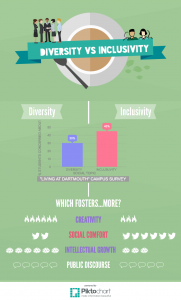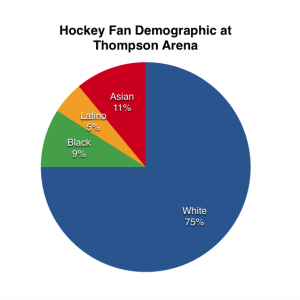Inclusive Diversity Neglected at Dartmouth?
It’s been determined that Thompson Arena possesses some qualities of a good public space. However, there exists an inherent tension between Fleming’s ideas of heterogeneity and identity when both are explored in Thompson Arena. For example, there is not much diversity present at Dartmouth’s hockey games, presumably because some students do not identify with the common sports fan identity. However, there is definitely diversity of all kinds (from race to religion to socioeconomic backgrounds) on Dartmouth’s campus, as shown in the 2019 Dartmouth class admissions evaluation. According to Fleming’s analysis of an ideal public space, diverse discourse leads to a collective identity. This is assuming, however, that people let go of personal judgment and stop discriminating against others. Thus, just because Dartmouth claims to have an abundance of diversity does not mean that students of minority backgrounds feel as though they are being included in the community.
Justin Maffet presents this theory that minority students still are neglected by Dartmouth’s initiatives for change in his Huffington Post article “How to Solve Dartmouth’s Diversity and Inclusion Challenges”. He challenges that minority students deserve more than just a conveyance of inclusion from the College. Adding more diversity does not lead to an openness of diversity. Students rightfully deserve inclusion in the fullest sense of the word- inclusion in community, in academics, in sports. The article in fact highlights the conflict between Fleming’s heterogeneity and identity when both exist on Dartmouth’s campus. If diversity and inclusive identity are to coexist without one arising at the cost of another, then we as an institution must learn to address identity while balancing heterogeneity.
Inclusive Diversity and Thompson Arena
Thompson Arena provides a special case study as to how diversity and identity interact with each other in a public space. In fact, Thompson Arena’s history provides the timeline of Dartmouth’s evolution from exclusive to inclusive. Before Thompson Arena, Davis Rink served as Dartmouth’s primary hockey arena from 1929-1975. Davis Rink is a prime example of a public space that is exclusive by design to socioeconomic and racial divisions. Except for reserved seating at the east end for those who could afford, the rest of the arena was standing room only. Fans pushed viciously against the fencing surrounding the ice and were disruptive and loud- as you can imagine, no good public discourse was generated. This unorganized and homogenous public space is exactly what Fleming’s piece argues against.
In 1973, construction of Thompson’s oval arena began, equalizing everyone to similar seating. Through the new design, Thompson Arena seems to bring Dartmouth one step closer to establishing Fleming’s ideal public space. However, I argue that socioeconomic, racial and gender boundaries are still indeed present in Thompson Arena and are actually obfuscated by its design.
During one of Dartmouth’s exciting hockey games on March 5th, 2016, I took a sample of 100 students in row 18 and tallied the racial demographic present today at Thompson Arena.
As seen from the results, despite Thompson’s change in design, there is still a relatively high percentage of white, economically-privileged students who attend hockey games in comparison to the rest of Dartmouth’s diverse minority groups. During my observations, I also discovered that students mostly sat in their prospective racial groups. For example, instead of tallying one white, one black, two asians, I counted numerous Asian students before switching to tallying a group of white students. These qualitative results demonstrate that more diversity does not lead to an openness of diversity. Thompson Arena does not facilitate both diversity and collective identity; rather, there are numerous diverse groups, but there is no collective feeling of inclusivity.

